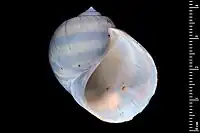| Rotzo Formation | |
|---|---|
| Stratigraphic range: Early-Late Pliensbachian ~ | |
 The Cimon del Latemar represents the internal lagoon of a fossil carbonate platform | |
| Type | Geological formation |
| Unit of | Calcari Grigi Group |
| Sub-units | Tovel Member[1] |
| Underlies | Calcari Grigi di Noriglio Formation |
| Overlies | Monte Zugna Formation |
| Lithology | |
| Primary | Lagoonal or restricted shallow subtidal; lithified, gray, silty marl. Paralic; ooidal, gray grainstone and bioturbated, intraclastic, ooidal, gray wackestone. Subtidal flat with mud banks and sand deposits.[2] |
| Other | Light-grey to yellowish-grey packstone, with oolites, bioclasts, algal lumps, pellets, dasycladacean algae, foraminifera, lituolids, and miliolids |
| Location | |
| Location | Vicenza Province: Trentino-Alto Adige, Southern Alps |
| Coordinates | 45°42′N 11°06′E / 45.7°N 11.1°E |
| Approximate paleocoordinates | 32°06′S 16°42′E / 32.1°S 16.7°E |
| Region | Veneto |
| Country | |
| Type section | |
| Named for | Rotzo |
 Rotzo Formation (Italy) | |
The Rotzo Formation (also known in older literature as the Noriglio Grey Limestone Formation) is a geological formation in Italy, dating to roughly between 189 and 183 million years ago and covering the Pliensbachian stage of the Jurassic Period in the Mesozoic Era.[3] Has been traditionally classified as a Sinemurian-Pliensbachian Formation, but a large and detailed dataset of isotopic 13C and 87Sr/86Sr data, estimated the Rotzo Formation to span only over the whole Pliensbachian.[4] The Rotzo Formation represented the Carbonate Platform, being located over the Trento Platform and surrounded by the Massone Oolite (marginal calcarenitic bodies), the Fanes Piccola Encrinite (condensed deposits and emerged lands), the Lombadian Basin Medolo Group and Belluno Basin Soverzene Formation (open marine), and finally towards the south, deep water deposits of the Adriatic Basin.[5] The also Pliensbachian Aganane Formation of Morocco represents a regional equivalent, both in deposition and faunal content.
Fossil prosauropod tracks have been reported from the formation.[6] This formation was deposited within a tropical lagoon environment, similar to modern Bahamas which was protected by oolitic shoals and bars from the open deep sea located to the east (Belluno Basin) and towards the west (Lombardia Basin). It is characterized by a rich paleontological content. It is notable mostly thanks to its great amount of big aberrant bivalves, among which is the genus Lithiotis, described in the second half of the nineteenth century. The unusual shape of Lithiotis and Cochlearites shells, extremely elongated and narrow, characterized by a spoon-like body space placed in a high position, rarely preserved, seems to suggest their adaptation to soft and muddy bottoms with a high sedimentation rate.[7] The Bellori outcrop displays about 20 m of limestones with intercalated clays and marls rich in organic matter and sometimes fossil wood (coal) and amber. The limestones are well stratified, with beds 10 cm to more than one metre thick, whereas the clayey levels range between 3 and 40 cm in thickness.[8][9]
Amoebae
The presence of the families Centropyxidae and Difflugiidae testifies the presence of a mixed marine-terrestrial depositional system, lacking large bodies of water.[10]
| Genus | Species | Location | Material | Notes | Images |
|---|---|---|---|---|---|
|
Tonezza del Cimone |
Calcareous Skeleton |
A testate amoebae, member of the family Centropyxidae inside Arcellinida. |
 Extant Example of the Genus Centropyxis | |
|
Tonezza del Cimone |
Calcareous Skeleton |
A testate amoebae, member of the family Difflugiidae inside Arcellinida. |
 Extant Example of the Genus Difflugia | |
|
Tonezza del Cimone |
Calcareous Skeleton |
A testate amoebae, member of the family Difflugiidae inside Arcellinida. |
 Extant Example of the Genus Pontigulasia | |
Invertebrates and mollusks
Microfossils of the Rotzo Formation consist of benthic foraminifera, calcareous algae, Ostracoda and coprolites. Foraminifera are mainly benthic agglutinated species belonging to the superfamily Lituolacea (suborder Textulariina), while lamellar and porcellaneous-walled species are very rare.[11] The bivalve Opisoma excavatum is very common.[12]
Branchipods
| Genus | Species | Stratigraphic position | Material | Notes | Images |
|---|---|---|---|---|---|
|
Gibbirhynchia[13] |
|
|
|
A Rhynchonellidan brachiopoda, member of Gibbirhynchiinae. Unusual genus in the Mediterranean region, more common on NW Europe |
|
|
Linguithyris[13] |
|
|
|
A Terebratulidan brachiopoda, member of Nucleatidae. Typical Mediterranean region taxon in the Pliensbachian |
|
|
Liospiriferina[13] |
|
|
|
A spiriferidan brachiopoda, member of Spiriferinidae. Typical Mediterranean region taxon in the Pliensbachian |
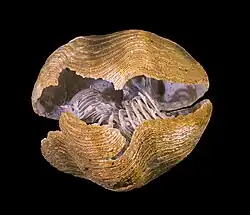 Specimen of the same genus |
|
Lychnothyris[13] |
|
|
|
A Terebratulidan brachiopoda, member of Plectoconchidae. Typical Mediterranean region taxon in the Pliensbachian, the main Branchiopod associated with the Lithiotids facies |
|
|
Prionorhynchia[13] |
|
|
|
A spiriferidan brachiopoda, member of Spiriferinidae. Typical Mediterranean region taxon in the Pliensbachian |
|
Bivalves
The Rotzo Formation is known mostly due to its massive bivalve associations of the genera Lithiotis, Cochlearites and Lithioperna that extended all along the Pliensbachian Trento Platform forming mass accumulations of specimens that formed Reef-Like structures.[14] This fauna appeared after the early Pliensbachian C-cycle perturbation, that triggered the diffusion of the Lithiotis Fauna, noted on the rapid widespread of this biota after the event layers.[14] All of the genera related with this fauna appeared on the lower Jurassic, and all but one became extinct before the Middle Jurassic.[15] This "Reefs" had a strong zonation, starting with the bivalves Gervilleioperna and Mytiloperna, restricted to intertidal and shallow-subtidal facies. Lithioperna is limited to lagoonal subtidal facies and even in some low-oxygen environments. Finally Lithiotis and Cochlearites are found in subtidal facies, constructing buildups.[15] This sections formed various kinds of ecosystems on the Trento platform, where it appeared in branched corals filled with (Spongiomorpha), Domal corals (Stromatoporida), tubular corals, Styllophyllidae corals, unidentified Cerioidea colonial corals, regular echinoid debris, sponges, and the solitary coral Opelismilia sp., with also aggregated snail shells.[15]
| Genus | Species | Stratigraphic position | Material | Notes | Images |
|---|---|---|---|---|---|
|
|
|
An oyster, member of Plicatostylidae inside Ostreida. A large bivalve, with a subequivalved shell, up to 60–70 cm high. It is one of the Three main bivalves recovered on the Lithiotis Facies, with its accumulations generally overlying megalodontid coquinas.[17] |
||
|
|
Isolated Shells |
A clam, member of Neomiodontidae inside Veneroidei. The so-called Eomiodon horizon represents the lower Rotzo Formation, composed of organic-rich marlstones with abundant specimens of this genus, typical of stressed environment with low salinity.[16] This genus considered an opportunistic shallow infaunal suspension feeder, and the marker genus for brackish environments.[19] |
||
|
|
Isolated Shells |
An Oyster, member of Bakevelliidae inside Pteriida. Found on greater accumulations on lower shale-dominated levels |
||
|
|
Isolated Shells |
An oyster, member of Plicatostylidae inside Ostreida. On the Rotzo formation this genus become abundant along rootlets, indicative of a very shallow and restricted lagoon or marsh environment.[17] |
||
|
|
|
An oyster, member of Plicatostylidae inside Ostreida. This genus was found to be a bivalve with a byssate juvenile stage that developed different modes of life on the adulthood depending on the individual density and bottom firmness.[18] |
||
|
|
|
An oyster, member of Plicatostylidae inside Ostreida. It is the major Bivalve identified on the formation, and the genus that gives the name to the Lithiotis fauna.[17] Large, large and aberrant bivalves present on mostly of the Trento Platform.[18] Its accumulation have had different denominations on literature, such as banks, bioherms, biostromes, bivalve reefs or bivalve mounds.[17] |
||
|
|
Isolated Shells |
|||
|
|
Isolated Shells |
A clam, member of Astartidae inside Carditida. Is considered a genus that evolved from shallow burrowing ancestors, becoming a secondarily semi-infaunal edgewise recliner adapted to photosymbiosis.[12] |
||
|
Pachygervillia[21] |
|
|
Isolated Shells |
An oyster, member of Plicatostylidae inside Ostreida. |
|
|
Pachyrisma[20] |
|
|
Isolated Shells |
A clam, member of Megalodontidae inside Megalodontida. |
|
|
|
Isolated Shells |
A clam, incertae sedis inside Pterioida. On the Rotzo formation this byssate bivalve indicates a shallow subtidal or intertidal environment.[18] |
||
Ammonoidea
| Genus | Species | Stratigraphic position | Material | Notes | Images |
|---|---|---|---|---|---|
|
Charmasseiceras sp. |
Shells of different sizes.[22] |
An ammonite of the family Schlotheimiidae. A very rare genus on the layers of the formation, being found only a few specimens. |
|||
|
|
Shells of different sizes.[22] |
An Ammonite of the Family Hildoceratidae |
 Fuciniceras | |
|
Juraphyllites libertus |
Contrada Ronchi (Recoaro Terme, Vicenza) |
Shells of different sizes.[22] |
Type member of the family Juraphyllitidae. It is the most abundant Ammonite found on the Rotzo Formation |
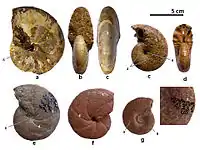 Juraphyllites (G) | |
|
Partschiceras[23] |
Partschiceras anonimum |
|
Shells of different sizes. |
An Ammonite of the family Phylloceratidae. |
|
|
|
Shells of different sizes. |
An Ammonite of the family Hildoceratidae. |
||
|
Ugdulenaia cf. ugdulenai |
|
Shells of different sizes. |
An Ammonite of the family Hildoceratidae. |
||
Gastropoda
| Genus | Species | Stratigraphic position | Material | Notes | Images |
|---|---|---|---|---|---|
|
Anticonulus[26] |
Anticonulus acutus |
Certosa di Vedana |
Shells |
A marine gastropod (Top Snail) of the Family Trochidae inside Trochoidea. |
|
|
Aptyxiella[20] |
|
|
Shells |
A marine gastropod (snail), member of Nerinellidae inside Nerineoidea. |
|
|
Ataphrus[26] |
|
Certosa di Vedana |
Shells |
A marine gastropod (snail), type genus of the Family Ataphridae inside Trochoidea. |
|
|
Austriacopsis[26] |
Austriacopsis austriaca |
Certosa di Vedana |
Shells |
A marine gastropod (snail) of the Family Fissurellidae inside Fissurelloidea. |
|
|
Discohelix excavata |
Certosa di Vedana |
Shells |
A marine gastropod (snail), type genus of the Family Discohelicidae inside Vetigastropoda. |
| |
|
Eucyclidae Indeterminate |
Certosa di Vedana |
Shells |
A marine gastropod (snail) of the Family Eucyclidae inside Seguenzioidea. |
||
|
Eucyclus[26] |
Eucyclus (Lokuticyclus) kericserensis |
Certosa di Vedana |
Shells |
A marine gastropod (snail), type genus of the Family Eucyclidae inside Seguenzioidea. |
|
|
Emarginula (Emarginula) vadanaei |
Certosa di Vedana |
Shells |
A marine gastropod (snail) of the family Fissurellidae inside Fissurelloidea. |
| |
|
Globularia sp. |
Tonezza del Cimone |
Shells |
A marine gastropod (snail) of the family Ampullinidae inside Campaniloidea. |
| |
|
Guidonia[26] |
Guidonia pseudorotula |
Certosa di Vedana |
Shells |
A marine gastropod (snail) of the family Trochonematidae inside Murchisoniina. |
|
|
|
Shells |
A marine gastropod (snail), type genus of the family Neritopsidae inside Cycloneritimorpha. |
||
|
Plectotrochus[26] |
Plectotrochus sp. |
Certosa di Vedana |
Shells |
A marine gastropod (Top snail) of the family Trochidae inside Trochoidea. |
|
|
Proacirsa[26] |
Proacirsa (Schafbergia) crenata |
Certosa di Vedana |
Shells |
A marine gastropod (snail) of the family Gordenellidae inside Allogastropoda. |
|
|
Pseudonerinea[27] |
Pseudonerinea terebra |
Tonezza del Cimone |
Shells |
A marine gastropod (snail) of the family Pseudonerineidae inside Nerineoidea. |
|
|
Pseudorhytidopilus[26] |
Pseudorhytidopilus detonii |
Certosa di Vedana |
Shells |
A marine gastropod (limpet) of the family Acmaeidae inside Patellogastropoda. |
|
|
Tretospira[27] |
Tretospira tridentina |
Tonezza del Cimone |
Shells |
A marine gastropod (periwinkle) of the family Purpurinidae inside Littorinoidea. |
|
Echinoidea
| Genus | Species | Stratigraphic position | Material | Notes | Images |
|---|---|---|---|---|---|
|
Polydiadema[28] |
|
|
Two specimens (MCV.20/02 and MCV.20/03) |
An Emiratiidae Phymosomatoidan. This Echinoids are recovered from a marginal marine layer, with abundant bivalves, gastropods, small corals, often found in concentrations due to tempestites.[28] |
|
Thylacocephala
| Genus | Species | Stratigraphic position | Material | Notes | Images |
|---|---|---|---|---|---|
|
Rugocaris[29] |
|
|
Medium-sized bivalved carapace |
A Concavicaridan Thylacocephalan. This specimen is a rathin rare case where there was the discover of a Thylacocephalan specimen in a rock deposed in a well oxigenated environment, while other finds come mostly from were from anaerobic environments.[29] Rugocaris lived in an epibathyal environment.[29] |
|
Crustacea
| Genus | Species | Stratigraphic position | Material | Notes | Images |
|---|---|---|---|---|---|
|
Klieana[30] |
Klieana sp. |
Tonezza del Cimone.[30] |
Valves |
An Ostracodan of the family Cytherideidae inside Cytheracea. The earliest record of the genus, the next youngest records of the genus are from Middle Jurassic sequences of France and Great Britain.[30] |
|
|
Limnocythere sp. |
Tonezza del Cimone.[30] |
Valves |
An Ostracodan of the family Limnocytherinae inside Cytheracea. High probability to be a new species of Limnocythere since the authors know of no other with similar posterolateral sulcation.[30] |
||
|
Phlyctisoma[31] |
Phlyctisoma cf.sinemuriana |
Valbona Area.[31] |
Slightly deformed Exuvia |
An Erymid Decapodan Crustacean common on in mediterranean rocks. With a rostrum about 1.3 cm long and the cephalic part of carapace about 2.5 cm the specimen probably reached a total length between 9-10 cm, being one of the largest specimens belonging to this genus. Frequent association with Thalassinoides burrows.[31][32] |
|
|
Phraterfabanella[30] |
Phraterfabanella tridentinensis |
Tonezza del Cimone.[30] |
Valves |
An Ostracodan of the family Cytherideidae inside Cytheracea. The assemblage is dominated (>95%) by this taxon.[30] It is a rather Medium-sized Ostracodan and markedly sexually dimorphic (males more elongate and more subrectangular versus shorter, more inflated and more subtriangular females).[30] it is likely that the palaeoenvironment was somewhat "stressed" and probably influenced by Salinity, where this genus would adapt better that Other Ostracodans (is related to the modern euryhaline species, Cyprideis torosa).[30] |
|
Annelida
| Genus | Species | Stratigraphic position | Material | Notes | Images |
|---|---|---|---|---|---|
|
Schistomeringos[33] |
|
|
Isolated scolecodonts |
A polychaete of the family Dorvilleidae. Unlike the modern counterparts that live in deeper environments, this species is found linked with shallow marine facies |
.jpeg.webp) Extant specimen of the same genus |
Invertebrate ichnofossils
In the Western Venetian Prealps a shallow-water, oceanic carbonate platform system, the Trento platform, developed on the Early Jurassic, producing a large succession of massive to well-bedded white Limestones, several 100 m (330 ft) thick that are part of the Calcari Grigi Group, where the Rotzo Formation is the Upper Member.[34] On the local limestone of the Rotzo Formation deep burrowing is a very common type of biogenic activity, as is shown due to the presence of a large characteristic network of burrows which reach down to the lagoonal, marly-clayey assigned strata, suggesting intense bioturbation by large unknown organisms, perhaps giant decapod crustaceans (Probably members of the family Erymidae), although, the burrows found are not closely related to the ones of Shrimps or other decapods, but resemble those of Stomatopoda and Malacostraca.[34] Other includes abandoned burrows, vertical biogenic action and infilling on the sea substrate.[34]
| Genus | Species | Stratigraphic position | Material | Notes | Images |
|---|---|---|---|---|---|
|
Coste dell’Anglone dinosaur ichnosite |
Star-shaped impressions |
An ichnogenus that represents the resting trace resting activity of sea stars (Asteroidea) and brittle stars (Ophiuroidea).[35] The recovered from the Rotzo formation are probably from specimens trapped on tidal changes.[35] |
||
|
Chomatichnus[34] |
|
Campomolon, Valbona |
Vertical burrows with preserved entrances |
It is difficult to suggest this ichnogenus because on the Formation the vertical and lined burrow with a deep central crater typical of Chomatichnus is never preserved.[34] It resemble described burrows of endobenthic thalassinidean decapods, specially Callianassa subterranea of modern North Sea, Callianassa major, Callianassa californensis or Upogebia pugettensis.[34] It can be also Serpulidae Polychaetan burrows. |
|
|
Campomolon, Valbona |
Burrowing and track Ichnofossils |
In the Rotzo Formation Ophiomorpha irregulaire local specimens the walls are extensively reworked by small, secondary burrowers assigned to the ichnogenus Chondrites.[31] Interpreted as the feeding burrow of a sediment-ingesting animal. |
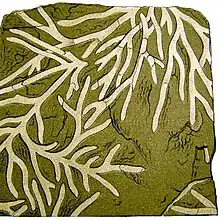 Chondrites | |
|
Glossifungites[34] |
|
Campomolon, Valbona |
Infilled abandoned burrows by coarse-grained skeletal debris |
On the local waters during the Lower Jurassic, water motion due to the hurricane action truncated many mounds causing changes on the deposition on the sea-floor and inducing various phases of substrate infillings with carbonate mud, fine-to coarse-grained skeletal debris and fecal pellets.[34] They are assigned to Priapulida, Serpulidae, Siboglinidae, Sabellidae or even Oweniidae. |
|
|
Campomolon, Valbona |
Burrowing and track Ichnofossils |
Two major types of Ophiomorpha where recovered, a smaller one from 2–4 cm in size and the larger one from 5–15 cm in diameter.[36] They are complex burrow systems lined with pelletoidal sediments generally infilled by coarse-grained detritus.[32] Specimens Seems partly destroyed by weathering.[31] |
 Ophiomorpha | |
|
Campomolon, Valbona |
Infilled abandoned burrows by coarse-grained skeletal debris |
Ichnofossils done by organisms advancing along the bottom surface. Very narrow, vertical or subvertical, slightly winding unlined shafts filled with mud. Locally, post hurricane burrows are found in fine-grained tempestite beds and muddy layers and they are Domichnia, Fodinichnia and Chemichnia.[34] |
 Skolithos | |
|
Campomolon, Valbona |
Burrowing and track Ichnofossils |
Thalassinoides suevicus has been found on mostly of the middle-upper part of the Rotzo Formation associated with muddy deposits. It ranges from 2–5 cm to 6–10 cm and the larger ones from 10 to 16 cm.[32] Y-shaped tunnels that seen in cross-section reveal circular walls made of pelletoidal grainstone, being more probably a fodichnia of a burrowing animal.[36] A few ichnofossils include simple cylindrical tubes up to 80 cm in length, that resemble crustacean described in Seychelles.[36] |
.jpg.webp) Thalassinoides | |
Vertebrata
Chondrichthyes
Episodic surficial bioturbation is common on the Rotzo Formation, due to invertebrates or fishes which alter intensely but rapidly the substrate for many cm in depth.[34] It this case the Bioturbation is assigned to mollusc predatory Chondrichthyes, such as Hybodontidae and Heterodontidae.[34] It also resembles present day flat angel sharks or Squatinidae and Guitarfish such as Rhinobatos.[34]
| Genus | Species | Stratigraphic position | Material | Notes | Images |
|---|---|---|---|---|---|
|
Chimaeriformes Indeterminate |
Campiluzzi Tunnel, west of Monte Buso. |
|
Uncertain Holocephalii remains |
||
|
Hybodus sp. |
|
|
A shark, type genus of the family Hybodontidae inside Hybodontiformes. A very prolific genus, found mostly on open marine units. |
||
|
Orthacodus sp |
|
Teeth |
A shark, type genus of the family Orthacodontidae inside Synechodontiformes. The teeth recovered resemble Orthacodus longidens, and are related to an epibathyal environment, near to a major carbonate platform shelf. |
||
Actinopterygii
Unidentified fish scales are known from the formation.[39]
| Genus | Species | Stratigraphic position | Material | Notes | Images |
|---|---|---|---|---|---|
|
Lepidotes sp. |
Campiluzzi Tunnel, west of Monte Buso. |
|
A member of the family Semionotidae inside Neopterygii. |
||
|
Indeterminate |
Campiluzzi Tunnel, west of Monte Buso. |
|
Actinopterygii fishes, the oldest record of the family |
||
|
Indeterminate |
Campiluzzi Tunnel, west of Monte Buso. |
|
Teleostei fishes, with genera know to form large Fish schools. |
||
|
Indeterminate |
Campiluzzi Tunnel, west of Monte Buso. |
|
Teleostei Fishes of small size, related to lagoonar environments |
||
|
Indeterminate |
Campiluzzi Tunnel, west of Monte Buso. |
|
The assigned teeth were found on i layer referred to a carbonate platform nearshore section, probably a lagoonar environment, where this and marine crocodrylomorphs lived. |
| |
Crocodyliformes
| Genus | Species | Location | Material | Notes | Images |
|---|---|---|---|---|---|
|
Indeterminate |
Monte Pasubio |
A Thalattosuchian Mesoeucrocodylian. It was cited the presence of fragmentary and poorly preserved remains of “Teleosauridae?”. There are at least two morphotypes, implying two genera or two species. The fossils were found on lagoonal deposits.[39] |
 Example of Thallatosuchian, Macrospondylus | ||
Dinosaurs
On the Inter-supratidal levels show that on the Rotzo Formation the Tracksites were rarely hit by Storm Waves.[42] Bella Lastra Tracksite recovers this environment, where the shales present (Where Fish & Crocodrylomorph Remains where found) are filled with plant roots, pollen grains, spores, freshwater ostracodes and the bivalve Eomiodon.[42] This was deposited mostly on a Lagoonar environment with abundant shed vegetation.[42] The main local Track record recovers specially Theropoda and Sauropoda, where the Sauropods are the most abundant tracks present (70%), moving the Otozum-like Sauropodomorphs of lower levels, with the climate changing from arid to humid.[42] The Coste dell’Anglone ichnosite is considered as derived from semi-arid tidal flat deposits, due to the abundance of Cheirolepidiaceae Pollen.[43] As the Pliensbachian Trento Platform is considered to be formed by a channelized barrier formed by sand, with reiterate tide emersions. The dinosaurs living here probably trampled on the subtidal flats looking for fishes trapped on tidal-derived ponds.[43]
Color key
|
Notes Uncertain or tentative taxa are in small text; |
| Dinosaurs of the Rotzo Formation | ||||||
|---|---|---|---|---|---|---|
| Genus | Species | Location | Member | Material | Notes | Images |
|
|
Tovel Member |
Footprints |
Theropod tracks, type member of the ichnofamily Anchisauripodidae, incertae sedis inside Neotheropoda. Probably related to Coelophysidae, such as Procompsognathus and Panguraptor or Coelophysoidea, such as Lophostropheus. All tracks were probably produced by individuals with the same functional anatomy of the hind foot.[42] |
||
|
|
Tovel Member |
Footprints |
Theropod tracks, member of the ichnofamily Eubrontidae, incertae sedis inside Neotheropoda. Includes Kayentapus sp. assigned to Sinosaurus-alike Theropods, but on the Rotzo Formation include also Abelisauroid-like tracks, similar to the foot of the genus Velocisaurus.[39] The tracks measure 30 cm long and have a distinctive robust digit III.[42] The Coste dell´Anglone tracksite had a pes with the metatarsal III elongated, as found on Dilophosaurus.[43] |
||
|
Moyenisauropus sp. |
|
Tovel Member |
Footprints |
Thyreophoran tracks, type member of the ichnofamily Moyenisauropodidae, incertae sedis inside Neornithischia. Is considered by some authors synonymous with the ichnogenus Anomoepus. The tracks adscribed share some morphological affinity with those referred to the Ankylosauridae, such as the ichnogenera Metatetrapodus and Tetrapodosaurus, and probably belonged to medium-sized Scelidosaurs or other kind of Thyreophorans. Include Specimens of up to 30 cm, suggesting +4 m long scelidosauroids.[46] |
||
|
|
Tovel Member |
Footprints |
Sauropodomorph tracks, member of the ichnofamily Otozoidae, incertae sedis inside Sauropodomorpha. A single trackway that strongly differs from the others found on the same tracksite. It wears morphological and morphometrical appearance that suggests relationships with a prosauropod trackmaker.[46] |
||
|
Parabrontopodus sp. A Parabrontopodus sp. B |
|
Tovel Member |
Footprints |
Sauropod tracks, type member of the ichnofamily Parabrontopodidae, incertae sedis inside Sauropodomorpha. Tracks from large basal members of Sauropoda. The larger tracks comprise elliptic pes (L=70 cm; W=50 cm) and subcirluar manus prints (L=33 cm; W=30 cm), what are among the largest known dinosaur tracks of the lower jurassic.[42] While nearly destroyed, the Tracks resemble the foot of the genus Barapasaurus. There is a type B of Parabrontopodus slightly smaller that resemble the genus Vulcanodon. |
||
Flora

%252C_Saw_Mill_Pond%252C_Caddo_Lake_State_Park%252C_Harrison_County%252C_Texas%252C_USA_(April_2017).jpg.webp)
The Rotzo Formation was deposited on a Lagoon on the emerged Trento Platform, leading to a well preserved fossil flora record, collected and studied since the 19th century.[48] The great level of floral fossilization has even allow to discovery fossil amber on the Bellori section. This amber has allowed to determine that the environment was a shallow tropical lagoon, only a few metres deep, closed seawards by oolitic shoals and bars.[48] This levels are dominated by a high abundance of Classopollis sp. (Cheirolepidiaceae), associated with dry and wet climates in coastal areas. The abundance of this group of conifers is also proven by the high presence of cuticles of Pagiophyllum cf. rotzoanum.[49] Beyond this genera, spores are highly diversified, including from Sphenophyta, Selaginellales to Ferns, with abundance (more than 50%) of trilete spores (Deltoidospora), what suggest a good freshwater availability corresponding to a wet climate, proven also by the presence of aquatic miospores of algae such as Botryococcus and Pseudoschizaea.[48] The climate was arid on some seasons with monsoon months. The abundance of marine fauna on this sediments, including fragments of corals, bryozoans, bivalves, echinoids, and foraminifera, suggest transport from brackish lagoons and marshes, probably occurred during storm events.[48] Overall data points to a marshy and/or submerged paleoenvironment, comparable to the present-day Taxodium swamp or cypress swamp and a Bahamian-type marine environment in a rather wet monsoonal climate as in the modern southeastern Asia.[48][49]
Amber
The Rotzo Formation records one of the few Early Jurassic assamblages with Amber in the world, the nicknamed "Bellori amber" found near the village of the same name.[50] Made mostly of small droplets of less than 1 mm with exceptionally preserved morphology its likely the amber producing plants were likely not stressed or affected by disease.[50] Due to the small size animal inclusion have not been found. However various plant materials, identified “mummified wood” and wood tissue are known.[50] Additionally large amounts of Circumpolles Cheirolepidiaceous pollen, and occasional freshwater algae Pseudoschizaea remains are included.[50] Several cuticle fragments are attributed to the araucariaceous or Hirmeriellaceae genus Pagiophyllum.[50] Those lived on a coastal and wet palaeoenvironment similar to the present-day Taxodium swamps with monsoonal seasons as in the modern southern Asia.[50]
Palynology
| Genus | Species | Location | Material | Notes |
|---|---|---|---|---|
|
Accincitisporites sp. |
|
Spores |
Incertae sedis; affinities with the Pteridophyta | |
|
Alisporites[50] |
Alisporites sp. |
|
Spores |
Affinities with Voltzia (Willsiostrobus) and Corystospermales |
|
Aratrisporites[50] |
Aratrisporites sp |
|
Spores |
Affinities with Lycophytes, in situ in Cyclostrobus, Lycostrobus and Annalepis zeiller. |
|
Auritulinasporites scanicus |
|
Spores |
Incertae sedis; affinities with the Pteridophyta | |
|
|
Spores |
Affinities with the family Osmundaceae in the Polypodiopsida. | |
|
Calamospora[50] |
Calamospora sp |
|
Spores |
Affinities with the Calamitaceae in the Equisetales. |
|
Camarozonosporites cf. heskemensis |
|
Spores |
Affinities with the family Lycopodiaceae in the Lycopodiopsida. | |
|
Cabochonicus[52] |
cf. Cabochonicus carbunculus |
|
Spores |
Affinities with Selaginellaceae |
|
Chasmatosporites[50] |
Chasmatosporites sp |
|
Spores |
Affinities with the family Zamiaceae in the Cycadales. It is among the most abundant flora recovered on the upper section of the coeval Rya Formation, and was found to be similar to the pollen of the extant Encephalartos laevifolius.[53] |
|
|
Pollen |
Affinities with the Hirmeriellaceae in the Pinopsida. | |
|
|
Spores |
Incertae sedis; affinities with the Pteridophyta | |
|
|
Pollen |
Affinities with the family Cycadaceae and Bennettitaceae. | |
|
|
Spores |
Incertae sedis; affinities with the Pteridophyta | |
|
|
Spores |
Affinities with the Selaginellaceae in the Lycopsida. | |
|
Bellori, Ponte Basaginocchi, Vajo dell’Anguilla |
Pollen |
Type pollen of the Erdtmanithecales, related to the Gnetales. | |
|
|
Spores. |
Affinities with Selaginellaceae | |
|
Granuloperculatipollis[50] |
|
|
Pollen |
Affinities with the Hirmeriellaceae in the Pinopsida. |
|
Horstisporites harrisii |
|
Spores |
Affinities with the Selaginellaceae in the Lycopsida. | |
|
Hughesisporites[52] |
cf. Hughesisporites orlowskae |
|
Spores |
Affinities with the Selaginellaceae in the Lycopsida. |
|
|
Spores |
Incertae sedis; affinities with the Pteridophyta | |
|
|
Spores |
Affinities with the family Lycopodiaceae in the Lycopodiopsida. | |
|
Limbosporites[50] |
|
|
Spores |
Affinities with the family Lycopodiaceae in the Lycopodiopsida. |
|
|
Spores |
Affinities with the Ophioglossaceae in the Filicales. | |
|
|
Spores |
Affinities with the family Lycopodiaceae in the Lycopodiopsida | |
|
|
Pollen |
Affinities with the family Karkeniaceae and Ginkgoaceae in the Ginkgoales. | |
|
|
Pollen |
Affinities with the family Cupressaceae in the Pinopsida. | |
|
|
Pollen |
||
|
|
Spores |
Affinities with the family Lycopodiaceae in the Lycopodiopsida | |
|
|
Spores |
Affinities with the family Lycopodiaceae in the Lycopodiopsida | |
|
|
Spores |
Incertae sedis; affinities with the Pteridophyta | |
|
|
Cysts |
Affinities with Chlorophyta | |
|
|
Pollen |
Affinities with the Hirmeriellaceae in the Pinopsida | |
|
|
Spores |
Incertae sedis; affinities with the Pteridophyta | |
|
|
Spores |
Affinities with the family Osmundaceae in the Polypodiopsida. | |
|
|
Spores |
Incertae sedis; affinities with the Pteridophyta | |
|
cf. Trileites murrayi |
|
Spores |
Affinities with Selaginellaceae | |
|
Verrutriletes[51] |
cf. Verrutriletes compostipunctatus |
|
Spores |
Incertae sedis; affinities with the Pteridophyta |
|
|
Pollen |
From the family Caytoniaceae in the Caytoniales. | |
Equisetales
| Genus | Species | Location | Material | Notes | Images |
|---|---|---|---|---|---|
|
|
Stems |
Affinities with Equisetaceae. Related to humid environments, the stems of local Equisetopsids show a rather large grown cycle, like the Bamboo on the modern Southern Asia, implicating tall Plants influenced by a Tropical Climate. |
||
|
|
Leaf Whorl |
Affinities with Phyllothecaceae inside Equisetales |
 Phyllotheca brongniartiana from the Rotzo Formation | |
Ferns
| Genus | Species | Location | Material | Notes | Images |
|---|---|---|---|---|---|
|
|
Fronds |
Affinities with Marattiales inside Marattiopsida. |
||
|
|
Fronds |
Affinities with Dipteridaceae inside Gleicheniales. |
||
|
|
Fronds |
Affinities with Polypodiales inside Polypodiopsida |
||
|
|
Fronds |
Affinities with Hymenophyllaceae inside Hymenophyllales. Tunbridge filmy ferns or Tunbridge filmy-fern, which forms large dense colonies in humid settings |
||
|
|
Fronds |
Affinities with Matoniaceae inside Gleicheniales. |
||
|
|
Fronds |
Affinities with Matoniaceae inside Gleicheniales. |
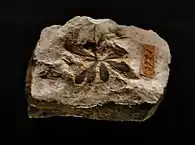 Marzaria paroliniana from the Rotzo Formation | |
|
|
Fronds |
Affinities with Matoniaceae inside Gleicheniales. |
||
|
|
Fronds |
Affinities with Matoniaceae inside Gleicheniales. |
||
|
|
Fronds |
Affinities with Dipteridaceae inside Gleicheniales. A rather lower Fern, with great resemblance with the modern genus Dipteris |
||
Seed Ferns
| Genus | Species | Location | Material | Notes | Images |
|---|---|---|---|---|---|
|
|
Fronds |
Affinities with Corystospermales inside Pteridospermopsida. On the Roverè di Velo collection, C. brauniana is the most common Frond found. The Fronds belong to medium to large arboreal Ferns. |
 Cycadopteris brauniana and Cycadopteris sp., both recovered from different locations of the Rotzo Formation | |
|
|
Fronds |
Affinities with Cyclopteridaceae inside Pteridospermatophyta. |
||
|
|
Fronds |
Affinities with Corystospermales inside Pteridospermopsida. This frons genus has been synonymized with Pachypteris , but it clearly differs due to the presence of odontopteridian pinnules, while Pachypteris has pinnules of the sphenopteridian type. Related to Arboreal Ferns. |
 Dichopteris visianica from the Rotzo Formation | |
|
|
Fronds |
Affinities with Cyclopteridaceae inside Pteridospermatophyta. |
 Lomatopteris jurensis from the Rotzo Formation | |
|
|
Leaflets |
Affinities with Caytoniales inside Pteridospermopsida. |
||
|
|
Leaflets |
Affinities with Caytoniaceae inside Caytoniales. There is a superficial doubt with the assignation to S. goeppertiana, and due to that Roverè di Velo specimen may be confirmed by comparing them with original Zigno's Material. |
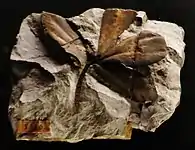 Sagenopteris nilssoniana from the Rotzo Formation | |
Bennettitales
| Genus | Species | Location | Material | Notes | Images |
|---|---|---|---|---|---|
|
|
Pinnate leaf fragments |
Affinities with Williamsoniaceae inside Bennettitales. Overall, the genus Otozamites is among the most abundant flora genus recovered on some of the levels of the Rotzo Formation, and also one of the most diversified. It belongs to arbustive Bennetites. |
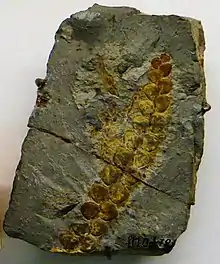 Otozamites bunburyanus from the Rotzo Formation | |
|
|
Leaflets |
Affinities with Williamsoniaceae inside Bennettitales. This genus has been related with the more arboreal family Williamsoniaceae, although is more probably from a low arboreal to arbustive Bennetite. |
||
|
|
Leaves |
Affinities with Williamsoniaceae inside Bennettitales. Was previously ascribed by Guiscardi (Director of the Geology Department of the Napoles University between 1861 al 1885) to Pachypteris visianica and Cycadopteris brauniana. |
 Ptilophyllum grandifolium from the Rotzo Formation | |
|
|
Leaflets |
Affinities with Williamsoniaceae inside Bennettitales. Related with Cycad-like trees. |
||
|
|
Bennettite "Flower" |
Affinities with Williamsoniaceae inside Bennettitales. Weltrichia is considered by some authors some kind of Bennetitalean Flower, putting that group on relationships with the Angiosperms. |
||
|
|
Bennettite "Flower" |
Affinities with Williamsoniaceae inside Bennettitales. |
 Williamsonia italica from the Rotzo Formation | |
|
|
Leaflets |
Affinities with Bennettitales inside Cycadeoidopsida. This genus has been related with the more arboreal family Williamsoniaceae, although is more probably from a low arboreal to arbustive Bennetite. |
||
Ginkgoopsida
| Genus | Species | Location | Material | Notes | Images |
|---|---|---|---|---|---|
|
Roverè di Velo |
Incomplete leaves |
Possible Affinities with Czekanowskiales, sometimes found inside Ginkgoopsida, yet their relationships are complicated. Was assigned the Podozamites genus and named them Podozamites zeillerianus. Represents shrub to arboreal taxa, with it´s best modern analogue being the Angiosperm Casuarina |
||
|
Val d´Assa |
Leaves |
Affinities with the genus Trichopitys, as probably a member of Karkeniaceae inside Ginkgoopsida, with strong resemblance with the genus Baiera | ||
Conifers
| Genus | Species | Location | Material | Notes | Images |
|---|---|---|---|---|---|
|
|
Branched shoots |
Affinities with Araucariaceae or Cheirolepidiaceae inside Coniferales. Brachyphyllum tropidimorphyrn shows close resemblance between African and Venetian conifers and its distribution suggests a lowland araucarian forest.[59] |
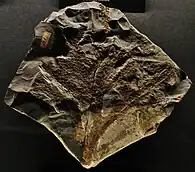 Brachyphyllum sp. from the Rotzo Formation | |
|
|
Branched shoots |
Affinities with Cheirolepidiaceae inside Coniferales. |
||
|
Grey limestones of Veneto. |
Branched shoots |
Affinities with Podocarpaceae inside Coniferales. |
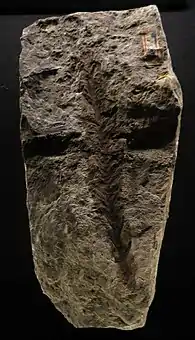 Elatocladus zignoi from the Rotzo Formation | |
|
Roverè di Velo |
|
Affinities with Araucariaceae or Cheirolepidiaceae inside Coniferales. One of the specimens was assigned to Otozamites massalongianus, due to confusing the overlapping appearance and the Otozamites-like shape of the leaves of the apical portion of the main shoot. |
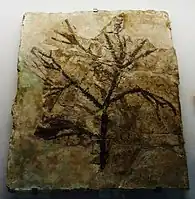 Pagiophyllum rotzoanum from the Rotzo Formation | |
|
|
|
Incertae sedis inside Coniferales, suggested as a member of it´s own family, the "Pelourdeaceae". A hygrophytic riparian conifer with herbaceous or shrubby habit. Some specimens are difficult to identify. |
||
|
Grey limestones of Veneto. |
Branched shoots |
Affinities with Palyssiaceae inside Coniferales, a genus that has been related to the fossil wood Phyllocladoxylon, being probably fronds of the Podocarpaceae family. |
||
|
Grey limestones of Veneto. |
Branched shoots |
Affinities with Cupressaceae inside Coniferales. Some specimens are difficult to identify and where mistaken as Bennetite fronds. |
 Taxites vicetina from the Rotzo Formation | |
Bibliography
- ↑ Castellarin, A.; Picotti, V.; Cantelli, L.; Claps, M.; Trombetta, L.; Selli, L.; Carton, A.; Borsato, A.; Daminato, F.; Nardin, M.; Santuliana, E.; Veronese, L.; Bollettinari, G. (2005). "Note Illustrative della Carta Geologica d'Italia alla scala 1:50.000, Foglio 080 Riva del Garda". Dipartimento Difesa del Suolo, Servizio Geologico d'Italia. 56 (2): 145. Retrieved 24 January 2022.
- ↑ "PBDB".
- ↑ Broglio Loriga, C.; Neri, C. (1976). "Aspetti paleobiologici e paleogeografici delle facies "Lithiotis" (Giurese inf.)". Rivista Italiana di Paleontologia e Stratigrafia. 82 (1): 651–151.
- ↑ Franceschi, M.; Dal Corso, J.; Posenato, R.; Roghi, G.; Masetti, D.; Jenkyns, H. C. (2014). "Early Pliensbachian (Early Jurassic) C-isotope perturbation and the diffusion of the Lithiotis Fauna: Insights from the western Tethys". Palaeogeography, Palaeoclimatology, Palaeoecology. 410 (1): 255–263. Bibcode:2014PPP...410..255F. doi:10.1016/j.palaeo.2014.05.025. Retrieved 12 November 2021.
- ↑ Masetti, D.; Fantoni, R.; Romano, R.; Sartorio, D.; Trevisani, E. (2012). "Tectonostratigraphic evolution of the Jurassic extensional basins of the eastern southern Alps and Adriatic foreland based on an integrated study of surface and subsurface data". AAPG Bulletin. 96 (11): 2065–2089. doi:10.1306/03091211087. Retrieved 12 November 2021.
- ↑ Mietto, P.; Roghi, G.; Zorzin, R. (2000). "Le impronte di dinosauri liassici dei Monti Lessini Veronesi [The Liassic dinosaur tracks from the Veronese Monti Lessini]". Bollettino del Museo Civico di Storia Naturale di Verona. Geologia Paleontologia Preistoria. 24 (2): 55–72.
- ↑ Masseti, D.; Posenato, R.; Bassi, D.; Fungagnoli, A. (2005). "The Rotzo Formation (Lower Jurassic) at the Valbona Pass (Vicenza Province)". IRIS Università degli Studi di Ferrara. 31 (5): 35–56. Retrieved 3 January 2022.
- ↑ Neri, Mirco; Papazzoni, Cesare Andrea; Vescogni, Alessandro; Roghi, Guido (2015). "Cyclical variation in paleoenvironments of the Rotzo formation (Lower Jurassic, Lessini Mts., N Italy)". STAMPA. 33 (1): 74–75.
- ↑ Urban, I. (2017). "Petrografia e geochimica delle ooliti del Giurassico inferiore della Piattaforma di Trento". Area 04 - Scienze della Terra > GEO/02 Geologia Stratigrafica e Sedimentologica. 1 (1): 1–203. Retrieved 3 January 2022.
- 1 2 3 4 BASSI, DAVIDE; FUGAGNOLI, ANNA; POSENATO, RENATO; SCOTT, DAVID B. (2008). "Testate Amoebae from the Early Jurassic of the Western Tethys, North-East Italy". Palaeontology. 51 (6): 1335–1339. doi:10.1111/j.1475-4983.2008.00817.x. ISSN 0031-0239. S2CID 129670565.
- ↑ Monaco, P.; Giannetti, A. (2001). "Stratigrafia tafonomica nel Giurassico inferiore dei Calcari Grigi della Piattaforma di Trento". Atti Ticinensi di Scienze della Terra. 42 (1): 175–209. Retrieved 3 January 2022.
- 1 2 3 Posenato, R. (2013). "Opisoma excavatum Boehm, a Lower Jurassic photosymbiotic alatoform-chambered bivalve". Lethaia. 46 (2): 424–437. doi:10.1111/let.12020. Retrieved 3 January 2022.
- 1 2 3 4 5 Vörös, A. (1993). "Jurassic microplate movements and brachiopod migrations in the western part of the Tethys". Palaeogeography, Palaeoclimatology, Palaeoecology. 100 (1–2): 125–145. Retrieved 13 November 2023.
- 1 2 Franceschi, M.; Dal Corso, J.; Posenato, R.; Roghi, G.; Masetti, D.; Jenkyns, H.C. (2014). "Early Pliensbachian (Early Jurassic) C-isotope perturbation and the diffusion of the Lithiotis Fauna: Insights from the western Tethys". Palaeogeography, Palaeoclimatology, Palaeoecology. 410 (4): 255–263. Bibcode:2014PPP...410..255F. doi:10.1016/j.palaeo.2014.05.025. Retrieved 3 January 2022.
- 1 2 3 4 5 6 Fraser, N.M.; Bottjer, D.J.; Fischer, A.G. (2004). "Dissecting "Lithiotis" Bivalves: Implications for the Early Jurassic Reef Eclipse". PALAIOS. 19 (1): 51–67. Bibcode:2004Palai..19...51F. doi:10.1669/0883-1351(2004)019<0051:DLBIFT>2.0.CO;2. S2CID 128632794. Retrieved 3 January 2022.
- 1 2 3 4 5 6 7 8 9 Bassi, D.; Boomer, I.; Fugagnoli, A.; Loriga, C.; Posenato, R.; Whatley, R.C. (1999). "Faunal assemblages and palaeoenvironment of shallow water black shales in the Tonezza area (Calcari Grigi, Early Jurassic, Southern Alps)" (PDF). Annali dell'Università di Ferrara, Sezione di Scienze della Terra. 8 (3): 1–16. Retrieved 3 January 2022.
- 1 2 3 4 5 6 7 8 9 10 11 12 Posenato, R.; Masetti, D. (2012). "Environmental control and dynamics of Lower Jurassic bivalve build-ups in the Trento Platform (Southern Alps, Italy)". Palaeogeography, Palaeoclimatology, Palaeoecology. 361 (2): 1–13. Bibcode:2012PPP...361....1P. doi:10.1016/j.palaeo.2012.07.001. Retrieved 3 January 2022.
- 1 2 3 4 5 6 7 8 9 Posenato, R.; Avanzini, M. (2004). "Short note–Nota breve "Lithiotis" beds of the Rotzo Formation (Calcari Grigi Group, Lower Jurassic) from Albaredo (Rovereto, Trento)" (PDF). Acta Geol. 81 (6): 23–28. Retrieved 3 January 2022.
- 1 2 Posenato, R.; Bassi, D.; Avanzini, M. (2013). "Bivalve pavements from shallow-water black-shales in the Early Jurassic of northern Italy: A record of salinity-and oxygen-depleted environmental dynamics". Palaeogeography, Palaeoclimatology, Palaeoecology. 369 (2): 262–271. Bibcode:2013PPP...369..262P. doi:10.1016/j.palaeo.2012.10.032. Retrieved 3 January 2022.
- 1 2 3 Negri, A. (1891). "Sopra alcuni fossili: raccolti nei Calcari grigi dei sette comuni". Boll. Soc. Geol. Ital. 10 (6): 309–331.
- ↑ Posenato, R.; Crippa, G. (2023). "An insight into the systematics of Plicatostylidae (Bivalvia), with a description of Pachygervillia anguillaensis n. gen. n. sp. from the Lithiotis Facies (Lower Jurassic) of Italy". Riv. It. Paleontol. Strat. 129 (3): 551–572. Retrieved 13 November 2023.
- 1 2 3 4 5 6 Mietto, P. (1985). "Ammoniti nella Piattaforma liassica Veneta". Rivista Italiana di Paleontologia e Stratigrafia. 91 (1): 3–14. Retrieved 3 January 2022.
- 1 2 3 4 5 Haas, O. (1913). "Die Fauna des mittleren Lias von Ballino im Sudtirol". Beitr. Paldont. Geol. Osterr. 26 (1): 1–161. Retrieved 3 January 2022.
- ↑ Sarti, C.; Ferrari, G. (1999). "The first record of an in situ ammonite from the upper part of the Calcari Grigi di Noriglio Formation of the Monte Baldo (Trentino, Northern Italy)". Neues Jahrbuch für Geologie und Paläontologie, Abhandlungen. 213 (3): 313–334. doi:10.1127/njgpa/213/1999/313. Retrieved 3 January 2022.
- ↑ Castelli, M. (1980). "Ammoniti del Pliensbachiano della collezione paleontologica del Museo civico di storia naturale di Brescia" (PDF). Natura Bresciana. 17 (2): 34–76. Retrieved 3 January 2022.
- 1 2 3 4 5 6 7 8 9 10 11 12 Gatto, R.; Monari, S. (2010). "Pliensbachian gastropods from Venetian Southern Alps (Italy) and their palaeobiogeographical significance". Palaeontology. 53 (4): 771–802. doi:10.1111/j.1475-4983.2010.00961.x. S2CID 140623279. Retrieved 3 January 2022.
- 1 2 3 Vorlicek, Lucia (2022). "Analisi paleontologica di alcuni gasteropodi del Giurassico inferiore del Veneto". Dipartimento di Geoscienze-Universita Padova. 34 (1): 1–22. Retrieved 13 November 2023.
- 1 2 Borghi, E.; Bottazzi, A. (2020). "First record of the genus Polydiadema Lambert, 1888 (Echinoidea) in the Jurassic of Italy" (PDF). Studi Trentini di Scienze Naturali. 99 (4): 15–19. Retrieved 3 January 2022.
- 1 2 3 4 Tintori, A.; Bigi, E.; Crugnola, G.; Danini, G. (1986). "A new Jurassic Thylacocephala Rugocaris indunensis gen. n. sp. n. and its paleoecological significance". Rivista Italiana di Paleontologia e Stratigrafia. 92 (2): 239–250. Retrieved 3 January 2022.
- 1 2 3 4 5 6 7 8 9 10 11 Boomer, I.; Whatley, R.; Bassi, D.; Fugagnoli, A.; Loriga, C. (2001). "An Early Jurassic oligohaline ostracod assemblage within the marine carbonate platform sequence of the Venetian Prealps, NE Italy". Palaeogeography, Palaeoclimatology, Palaeoecology. 166 (3–4): 331–344. Bibcode:2001PPP...166..331B. doi:10.1016/S0031-0182(00)00216-9. Retrieved 3 January 2022.
- 1 2 3 4 5 6 7 8 Garassino, A.; Monaco, M. (2000). "Burrows and body fossil of decapod custaceans i the Calcari Grigi, Lower Jurassic, Treno Platform (Italy)". Geobios. 34 (3): 291–301.
- 1 2 3 4 5 6 Monaco, P. (2000). "Decapod burrows (Thalassinoides, Ophiomorpha) and crustacean remains in the Calcari Grigi, lower Jurassic, Trento platform (Italy)". 1st Workshop on Mesozoic and Tertiary decapod crustaceans, Studi e Ricerche, Associazione Amici del Museo Civico "G.Zannato" Montecchio Maggiore (Vicenza), October 6–8, 2000. 1 (1): 55–57. Retrieved 3 January 2022.
- ↑ Van Erve, A. W. (1981). "Lower Jurassic scolecodonts from the vicentinian Alps (northeastern Italy), representing the family Dorvilleidae Chamberlin, 1919". Review of Palaeobotany and Palynology. 34 (2): 225–235. doi:10.1016/0034-6667(81)90040-3. Retrieved 17 April 2023.
- 1 2 3 4 5 6 7 8 9 10 11 12 13 14 15 16 Monaco, P.; Giannetti, A. (2002). "Three-dimensional burrow systems and taphofacies in shallowing-upward parasequences, lower Jurassic carbonate platform (Calcari Grigi, Southern Alps, Italy)". Facies. 47 (1): 57–82. doi:10.1007/BF02667706. S2CID 129735856. Retrieved 3 January 2022.
- 1 2 3 Bernardi, M.; Ferreti, P.; Petti, F.M.; Avanzini, M. (2009). "Asteriacites isp. from the Coste dell'Anglone dinosaur ichnosite (Valle del Sarca, Trentino, NW Italy)". Giornate di Paleontologia. 43 (1): 28–31.
- 1 2 3 4 5 6 Monaco, P.; Garassino, A. (2001). "Burrowing and carapace remains of crustacean decapods in the Calcari Grigi, Early Jurassic, Trento platform". Geobios. 34 (3): 291–301. doi:10.1016/S0016-6995(01)80077-2. Retrieved 3 January 2022.
- 1 2 3 4 Franceschi, F.; Bernardi, M. (2021). "The higher ecological tiers of the Rotzo Formation: first clues on a forgotten vertebrate fauna". _PaleoDays 2021 - XXI Convegno della Società Paleontologica Italiana. 2 (1): 6–7. Retrieved 3 January 2022.
- 1 2 3 4 5 Franceschi, Fabio; Bernardi, Massimo (2020). "Vertebrate remains from the Rotzo Formation (Lower Jurassic, Trento Platform, Italy): preliminary note" (PDF). Fossilia - Reports in Palaeontology. 78 (6): 25–27. Retrieved 3 January 2022.
- 1 2 3 4 5 6 7 8 9 Petti, F. M.; Bernardi, M.; Todesco, R.; Avanzini, M. (2011). "Dinosaur footprints as ultimate evidence for a terrestrial environment in the late Sinemurian trento carbonate platform". PALAIOS. 26 (10): 601–606. Bibcode:2011Palai..26..601P. doi:10.2110/palo.2011.p11-003r. S2CID 128845481. Retrieved 3 January 2022.
- 1 2 3 4 5 Avanzini, M. (1998). "Resti di vertebrati dal Giurassico inferiore della piattafor-ma di Trento (Italia settentrionale) Nota prelimiare". Studi Trentini diScienze Naturali. Acta Geologica. 73 (7): 75–80.
- ↑ Avanzini, M. (1998). "Resti di rettili continentali dal Giurassico inferiore della piattaforma di Trento (Italia settentrionale)". Studi Trentini di Scienze Naturali - Acta Geologica. 73 (4): 75–80.
- 1 2 3 4 5 6 7 Guidorroghi, R. (2006). "Lower Jurassic (Hettangian-Sinemurian) dinosaur track megasites, southern Alps, Northern Italy". The Triassic-Jurassic Terrestrial Transition. 37 (8): 207.
- 1 2 3 4 5 Petti, F. M.; Bernardi, M.; Ferretti, P.; Tomasoni, R.; Avanzini, M. (2011). "Dinosaur tracks in a marginal marine environment: the Coste dell'Anglone ichnosite (Early Jurassic, Trento Platform, NE Italy)". Italian Journal of Geosciences. 130 (1): 27–41. Retrieved 3 January 2022.
- 1 2 3 4 Petti, F.M.; Avanzini, M.; Antonelli, M; Bernardi, M.; Leonardi, G.; Manni, R.; Mietto, P.; Pignatti, J.; Piubelli, D.; Sacco, E.; Wagensommer, A. (2020). "Jurassic tetrapod tracks from Italy: a training ground for generations of researchers". Tetrapod Ichnology in Italy: The State of the Art. Journal of Mediterranean Earth Sciences. 12 (3): 137–165. Retrieved 3 January 2022.
- ↑ Avanzini, M.; Petti, F. M. (2008). "Updating the dinosaur tracksites from the Lower Jurassic Calcari Grigi Group (Southern Alps, northern Italy)". Studi Trentini di Scienze Naturali, Acta Geologica. 83 (8): 289–301. Retrieved 3 January 2022.
- 1 2 3 4 Avanzini, M.; Leonardi, G.; Tomasoni, R.; Campolongo, M. (2001). "Enigmatic dinosaur trackways from the Lower Jurassic (Pliensbachian) of the Sarca Valley, northeast Italy". Ichnos. 8 (3–4): 235–242. doi:10.1080/10420940109380190. S2CID 128584482. Retrieved 3 January 2022.
- ↑ Franceschi, M.; Martinelli, M.; Gislimberti, L.; Rizzi, A.; Massironi, M. (2015). "Integration of 3D modeling, aerial LiDAR and photogrammetry to study a synsedimentary structure in the Early Jurassic Calcari Grigi (Southern Alps, Italy)". European Journal of Remote Sensing. 48 (1): 527–539. doi:10.5721/EuJRS20154830. S2CID 134429593.
- 1 2 3 4 5 Neri, M.; Papazzoni, C.A.; Kustatscher, E.; Roghi, G. (2015). "Paleoenvironmental data from the amber-bearing levels of the Rotzo formation (Pliensbachian, Lower Jurassic), Monti Lessini (Verona, Italy)". In XV Edizione delle "Giornate di Paleontologia", PaleoDays. 15 (2): 78–79. Retrieved 3 January 2022.
- 1 2 3 Neri, M.; Kustatscher, E.; Roghi, G.; Papazzoni, C.A. (2016). "Paleobotanical assemblage from the Lower Jurassic amber bearing levels from the Rotzo Formation, Monti Lessini (Venetian Prealps, Northern Italy)". In the Micropaleontological Society, 5th Silicofossil and Palynology Joint Meeting. 16 (2): 33.
- 1 2 3 4 5 6 7 8 9 10 11 12 13 14 15 16 17 18 19 20 21 22 23 24 25 26 27 28 29 30 31 32 33 34 35 36 Neri, M.; Roghi, G.; Ragazzi, E.; Papazzoni, C. A. (2017). "First record of Pliensbachian (Lower Jurassic) amber and associated palynoflora from the Monti Lessini (northern Italy)". Geobios. 50 (1): 49–63. doi:10.1016/j.geobios.2016.10.001. Retrieved 3 January 2022.
- 1 2 3 4 5 6 7 8 9 10 11 12 13 14 15 16 17 18 19 20 21 22 23 24 25 26 27 Van Erve, A.W. (1977). "Palynological investigation in the Lower Jurassic of the Vicentinian Alps (Northeastern Italy)". Review of Palaeobotany and Palynology. 23 (6): 1–117. doi:10.1016/0034-6667(77)90004-5. Retrieved 3 January 2022.
- 1 2 3 4 5 6 7 8 9 10 11 12 13 14 15 16 17 18 19 Neri, M.; Kustatscher, E.; Roghi, G. (2018). "Megaspores from the Lower Jurassic (Pliensbachian) Rotzo Formation (Monti Lessini, northern Italy) and their paleoenvironmental implications". Palaeobiodiversity and Palaeoenvironments. 98 (1): 102–118. doi:10.1007/s12549-017-0314-z. S2CID 133666705. Retrieved 3 January 2022.
- ↑ Guy-Ohlson, D.. 1988. The use of dispersed palynomorphs referable to the form genus Chasmatosporites (Nilsson) Pocock and Jansonius, in Jurassic biostratigraphy. Congreso Argentino de Paleontologia y Bioestratigrafia 3(1–2). 5- 13. Accessed 09 April 2021.
- 1 2 3 4 5 6 7 8 9 10 11 12 13 14 15 16 17 18 19 20 21 22 23 24 25 26 De Zigno, A. (1856–1868). "Flora fossilis formationis Oolithicae". Tipografia del Seminario di Padova. 1 (1): 1–426. Retrieved 3 January 2022.
- 1 2 3 4 5 6 7 8 9 10 11 12 13 14 15 16 17 18 19 20 21 Wesley, A. (1956). "Contributions to the knowledge of the flora of the Grey Limestones of Veneto, Part 1". Mem. Ist. Geol. Min. Univ. Padova. 19 (3): 1–69.
- 1 2 3 4 5 6 7 8 9 10 11 12 13 14 15 16 17 De Zigno, A. (1885). "Flora fossilis formationis oolithicae Volume 2". Padova, Tip. Del Seminario. 3 (2): 1–356. Retrieved 3 January 2022.
- 1 2 3 4 5 6 7 Bartiromo, A.; Barone Lumaga, M.R. (2009). "Taxonomical revision of the Collection of Jurassic plants from Roverè di Velo (Veneto, northern Italy) stored in the Palaeontological Museum of the University of Naples "Federico II"". Bollettino della Società Paleontologica Italiana. 48 (3): 1–13. Retrieved 3 January 2022.
- 1 2 3 4 5 6 7 8 9 10 11 12 Wesley, A. (1958). "Contributions to the knowledge of the flora of the Grey Limestones of Veneto, Part 2". Mem. Ist. Geol. Min. Univ. Padova. 21 (1): 1–57.
- ↑ Krassilov, V. A. (1978). "Araucariaceae as indicators of climate and paleolatitudes". Review of Palaeobotany and Palynology. 26 (1–4): 113–124. doi:10.1016/0034-6667(78)90008-8.

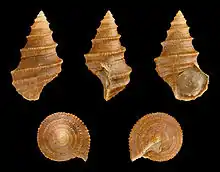
.jpg.webp)
